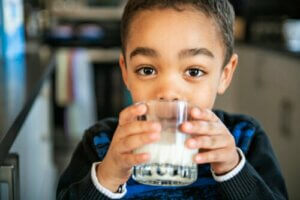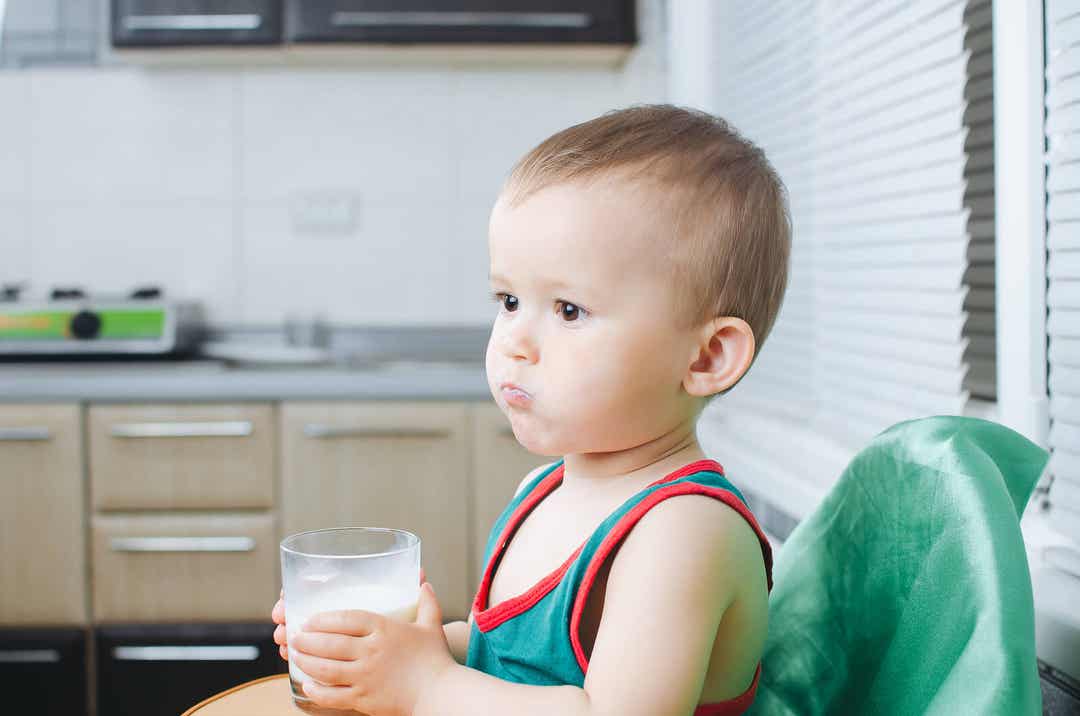How Much Milk Should Children Drink According to Their Age?

One of the most frequent doubts regarding child nutrition has to do with how much milk children should drink according to their age. This is one of the most complete foods for babies, but it’s important to administer it in optimal doses in order to meet nutritional requirements.
Experiencing a nutrient deficit could be counterproductive for the development and growth of little ones. In the same way, establishing a hypercaloric feeding pattern could lead to the development of excess weight, which isn’t advisable for health in the medium term.
The quantity of milk according to the age of the child
During the first 3 years of life, children should consume around half a liter of milk per day. This way, they meet their calcium requirements, which are around 800 milligrams per day. It’s important to note that this mineral’s essential for maintaining good bone health, according to a study published in Nutrients.

From the age of 3 years and up, it’s best for children to consume at least a couple of servings of dairy products per day. They can do this by alternating between milk and yogurt, as well as cheese. You can even include other fermented foods, such as kefir, in this group. They provide a good amount of probiotics, live bacteria that are beneficial to intestinal health.
You should give children whole milk
As a general rule, the milk that you should give to children (and also to adults) should be whole milk. If you remove the fat from the food, then you lose a large amount of essential fat-soluble vitamins, such as A and D. In addition, many of the dairy products on the market are enriched with vitamin D, thus increasing their nutritional density.
Milk fat, despite being saturated, is considered healthy. This is because it has a cis configuration at the molecular level. Only trans fatty acids are harmful to health, as research that appeared in the journal Diabetes & Metabolic Syndrome demonstrates.
Solutions for allergies and intolerances
If the child has an allergy to cow’s milk proteins, breastfeeding’s the best alternative whenever possible. In addition, there are a series of special hydrolyzed milks for these kinds of babies. Here the milk proteins are broken down, preventing them from causing damage to the hypersensitive organism.
In any case, it’s important to note that allergy to cow’s milk proteins is likely to go away on its own spontaneously over the years. The case of lactose intolerance is different.
In this situation, it’s the sugar in milk–lactose–that causes damage. This condition causes stomach problems and diarrhea. Milk is, therefore, intolerable, but not dairy products such as yogurt, as they contain less lactose. Offering a variety of lactose-free milk alternatives can be an effective solution to the problem.
Be careful with the amount of whole milk you give to children
Although it’s a beneficial food, be aware that whole milk’s a very energetic drink. If children consume it excessively, it could produce a hypercaloric context that could lead to weight gain.
Any situation of excess weight or obesity is a risk for children, so it’s crucial that you adjust milk consumption to their daily energy needs. For this reason, you shouldn’t exceed the daily intake we mentioned above. Therefore, it’s important to take into account how much milk children should drink according to their age.

Milk for children, a healthy food
As you’ve been able to verify, the intake of whole milk is positive for children. Around 16 ounces of milk a day would be optimal during the first stages of life, followed by a couple of servings of dairy products a day. However, consumption may increase in adults in the context of sports or increased needs.
However, you should always keep in mind that, when consuming milk, it’s always best to choose the whole milk variety. The nutritional density of this product is higher, as well as its energy content. It has more vitamins than skimmed or partially-skimmed versions. We hope we’ve resolved your doubts regarding the amount of milk that children should drink according to their age.
One of the most frequent doubts regarding child nutrition has to do with how much milk children should drink according to their age. This is one of the most complete foods for babies, but it’s important to administer it in optimal doses in order to meet nutritional requirements.
Experiencing a nutrient deficit could be counterproductive for the development and growth of little ones. In the same way, establishing a hypercaloric feeding pattern could lead to the development of excess weight, which isn’t advisable for health in the medium term.
The quantity of milk according to the age of the child
During the first 3 years of life, children should consume around half a liter of milk per day. This way, they meet their calcium requirements, which are around 800 milligrams per day. It’s important to note that this mineral’s essential for maintaining good bone health, according to a study published in Nutrients.

From the age of 3 years and up, it’s best for children to consume at least a couple of servings of dairy products per day. They can do this by alternating between milk and yogurt, as well as cheese. You can even include other fermented foods, such as kefir, in this group. They provide a good amount of probiotics, live bacteria that are beneficial to intestinal health.
You should give children whole milk
As a general rule, the milk that you should give to children (and also to adults) should be whole milk. If you remove the fat from the food, then you lose a large amount of essential fat-soluble vitamins, such as A and D. In addition, many of the dairy products on the market are enriched with vitamin D, thus increasing their nutritional density.
Milk fat, despite being saturated, is considered healthy. This is because it has a cis configuration at the molecular level. Only trans fatty acids are harmful to health, as research that appeared in the journal Diabetes & Metabolic Syndrome demonstrates.
Solutions for allergies and intolerances
If the child has an allergy to cow’s milk proteins, breastfeeding’s the best alternative whenever possible. In addition, there are a series of special hydrolyzed milks for these kinds of babies. Here the milk proteins are broken down, preventing them from causing damage to the hypersensitive organism.
In any case, it’s important to note that allergy to cow’s milk proteins is likely to go away on its own spontaneously over the years. The case of lactose intolerance is different.
In this situation, it’s the sugar in milk–lactose–that causes damage. This condition causes stomach problems and diarrhea. Milk is, therefore, intolerable, but not dairy products such as yogurt, as they contain less lactose. Offering a variety of lactose-free milk alternatives can be an effective solution to the problem.
Be careful with the amount of whole milk you give to children
Although it’s a beneficial food, be aware that whole milk’s a very energetic drink. If children consume it excessively, it could produce a hypercaloric context that could lead to weight gain.
Any situation of excess weight or obesity is a risk for children, so it’s crucial that you adjust milk consumption to their daily energy needs. For this reason, you shouldn’t exceed the daily intake we mentioned above. Therefore, it’s important to take into account how much milk children should drink according to their age.

Milk for children, a healthy food
As you’ve been able to verify, the intake of whole milk is positive for children. Around 16 ounces of milk a day would be optimal during the first stages of life, followed by a couple of servings of dairy products a day. However, consumption may increase in adults in the context of sports or increased needs.
However, you should always keep in mind that, when consuming milk, it’s always best to choose the whole milk variety. The nutritional density of this product is higher, as well as its energy content. It has more vitamins than skimmed or partially-skimmed versions. We hope we’ve resolved your doubts regarding the amount of milk that children should drink according to their age.
All cited sources were thoroughly reviewed by our team to ensure their quality, reliability, currency, and validity. The bibliography of this article was considered reliable and of academic or scientific accuracy.
- Vannucci L, Fossi C, Quattrini S, Guasti L, Pampaloni B, Gronchi G, Giusti F, Romagnoli C, Cianferotti L, Marcucci G, Brandi ML. Calcium Intake in Bone Health: A Focus on Calcium-Rich Mineral Waters. Nutrients. 2018 Dec 5;10(12):1930. https://pubmed.ncbi.nlm.nih.gov/30563174/
- Islam MA, Amin MN, Siddiqui SA, Hossain MP, Sultana F, Kabir MR. Trans fatty acids and lipid profile: A serious risk factor to cardiovascular disease, cancer and diabetes. Diabetes Metab Syndr. 2019 Mar-Apr;13(2):1643-1647. https://pubmed.ncbi.nlm.nih.gov/31336535/
This text is provided for informational purposes only and does not replace consultation with a professional. If in doubt, consult your specialist.








